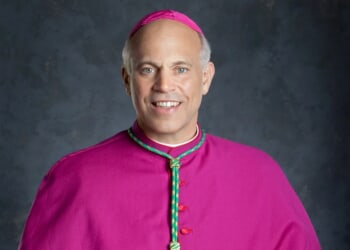Thirty out of 65 residents of a $17 million Salt Lake City project to solve homelessness through “Housing First” are dead, according to an investigation by Utah Stories magazine. Dubbed the Magnolia Apartments, each unit featured quartz countertops, a city view balcony, and an ideal location in downtown.
This program was a flagship initiative of Utah’s “Housing First” policy, an approach to homelessness taken across the country that provides free housing with no strings attached. This means that there is no requirement for someone to undergo drug treatment or seek out a job before receiving a housing unit. Promoting Housing First nationally through federal pressure was a project of the Biden administration.
Utah Stories estimated a $350,000 cost for each Magnolia apartment had they been sold at market rate. Now, an inside source told Richard Markosian, a reporter for Utah Stories, that “the rooms are torn apart and drug use is rampant.”
When Markosian visited the project, he found broken doors and residents who described their luxury living as “drug dens with granite counters.”
Former resident Kelly Johnson recounted witnessing a murder and several drug overdoses, including a friend who was forcefully “shot up with heroin … and robbed.” As for the staff hired by the city, often people in transitional programs themselves, “when someone dies … they’re not found for days.”
The entire complex received 12 hours a week of security, leaving it open for “drugs and weapons” to infiltrate and for residents to run a “prostitution ring” without oversight.
Utah Stories reported that its source said that “the majority of people are still living like they are homeless,” a claim current residents affirm. This means few residents have jobs and many panhandle outside of the high-quality apartments provided to them at a cost to the taxpayers.
Residents have reported roving gangs of drug dealers and the open use of crack cocaine and heroin on the street outside the Magnolia, turning a previously safe area into a haven for crime. Stray dogs have attacked locals and their pets.
The apartments targeted those who were homeless on repeated occasions for at least three years. In other words, those who are most likely to suffer from drug addiction or have past criminal prosecutions. (RELATED: Feds Flub Homelessness by Ignoring Addiction)
This has been a common experience across the country in apartments provided by Housing First programs. Those without the capacity for independent living are given tools without a blueprint and find themselves continuing destructive behavior. Their apartments become hives of crime, squalor, and death for the very people they were meant to help.
NPR prematurely lauded Utah in 2015 as having claimed victory over homelessness using the Housing First model. The demise of the Magnolia demonstrates the failure of Utah’s use of the policy. Other states have faced similar reckonings.
The American Spectator reached Markosian, the author of the Utah Stories article, for comment. He explained that his sources for his claim that “half of the people who got residence there four years ago have died” were “tenants who lived there and an anonymous employee at the Magnolia.” Markosian clarified that “most of them have died of drug overdose.”
Markosian told The American Spectator about a police officer who had told him that the prison had only 50 beds for homeless offenders. Only the worst offenders would ever be punished, leaving most offenders on the street.
In her recent book, Newsom Unleashed, Ellie Gardey Holmes outlines the failure of Housing First policies in addressing homelessness in California. She cites California homeless resource provider Andy Bales, who noticed drug abuse and crime being exacerbated by Housing First policies, a similar phenomenon to the Magnolia in Utah. (RELATED: Gavin Newsom Cannot Escape His Embarrassing Legacy on Homelessness)
Holmes describes a $12 billion investment by Governor Newsom into Housing First that resulted in total failure. One study, Holmes notes, found an average decrease of 0.04 individuals in the homeless population for each unit of targeted housing built from this unimaginable investment. (RELATED: Will California Go Forward or Backward on Homelessness?)
Utah has taken note of the national discontent with the Housing First approach, as its legislature voted for a bill in February of 2025 to pull back programs that do not address drug problems first before providing housing. Federal requirements still prevent alcoholism from being a housing criterion, but the Utah legislature overwhelmingly approved a resolution calling for an end to this requirement for federal funds.
Shiv Parihar is an editorial intern at The American Spectator. You can follow him on X @ShivomMParihar.
READ MORE from Shiv Parihar:
Middle East Christians Face Choice Between Extermination and Exodus
Exclusive: Anti-Regime Iranians Speak Out, Discuss Widespread Discontent With the Mullahs’ Rule



![Man Arrested After Screaming at Senators During Big Beautiful Bill Debate [WATCH]](https://www.right2024.com/wp-content/uploads/2025/06/Man-Arrested-After-Screaming-at-Senators-During-Big-Beautiful-Bill-350x250.jpg)












